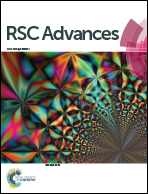Nanofibrous artificial skin substitute composed of mPEG–PCL grafted gelatin/hyaluronan/chondroitin sulfate/sericin for 2nd degree burn care: in vitro and in vivo study†
Abstract
The aim of this study was to investigate the efficacy of a skin substitute composed of mPEG–PCL–grafted-gelatin (Bio-Syn)/hyaluronan/chondroitin sulfate/sericin and to study its in vitro biocompatibility with human fibroblasts, human keratinocytes and hMSCs in terms of cellular adhesion and proliferation (∼5–6 fold). mPEG–PCL was grafted into a gelatin backbone via a Michael addition reaction to prepare Bio-Syn and it was characterized using ATR-FTIR, 1H NMR and TNBS assay. Additionally, keratinocyte–hMSC contact co-culture studies showed that Bio-Syn composite scaffolds loaded with sericin promote hMSCs’ epithelial differentiation with regard to qRT-PCR gene expression (ΔNp63α and keratin 14) and expression of various epithelial markers (Pan-cytokeratin, ΔNp63α and keratin 14). In vivo efficacy studies on a 2nd degree burn wound model in Wistar rats showed an improved rate of wound contraction, histology (H&E and Van Gieson’s staining) and pro-healing marker (hexosamine, hydroxyproline, etc.) expression in granular tissue compared to using the commercial dressing Neuskin™ and a cotton gauze control.



 Please wait while we load your content...
Please wait while we load your content...